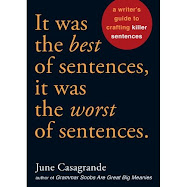Reading a lot about our country's economic woes today, I'm feeling the urge to try to be helpful. So, straying a bit from my usual tone, here are some language tips for job seekers and resume writers. I hope someone finds them useful!
* * * * * * * * * * * * * * * * * * * * * * * * * * * * * * * * * * * * * * * * * Be consistent in your sentence structure. If, under employer XYZ Co., you write “Led a team of eight,” do not under employer Widgets Inc. start adding the pronoun "I," as in, “I led a team of eight.” Sentence fragments are fine on resumes, but inconsistency can disorient your reader.
* Speaking of “Inc.,” you don’t have to set it off with commas. But if you choose to put a comma before it, put one after it, too:
“I worked for Widgets, Inc., in the 1980s.” = Good
“I worked for Widgets Inc. in the 1980s.” = Also good
“I worked for Widgets, Inc. in the 1980s.” = Bad
* Similarly, for years in dates, be sure to use a comma before and after:
“I worked for Apple from Dec. 1, 1999, to July 22, 2008, designing software.” = Good
“I worked for Apple from Dec. 1, 1999 to July 22, 2008 designing software.” = Bad
* Know “it’s” from “its”: You helped the company usher in
its strongest quarter, NOT
it’s. The reason: “its” is an exception to the possessives rule. The possessive form takes no apostrophe. “It’s” is a contraction of “it is” or “it has.” “It’s good to see you.” Consider this a priority. Any employer who knows the difference will likely look down on you if you don’t.
* Don’t mess up “there,” “their,” and “they’re.” The first one’s a place, the second shows possession, the third is a contraction of “they” and “are.” When in doubt, look them up.
* Before sending your resume/letter, try to get a friend to read it. A reader can often catch things that the writer cannot. Then read the whole document
aloud. It’s the best way to assure you stay focused on close reading during a final proofread. Also run spellcheck, but beware that it’s not totally reliable.
* The past tense of “lead” is “led,” NOT “lead.” Don’t confuse the past tense of the verb with the stuff in your pencil. Yesterday, I
led a team of eight in designing
lead pencils.
* Remember the basic possessives rule: For singular nouns, add an apostrophe and an S: “The dog’s tail.” For plural nouns, add just the apostrophe: “All the dogs’ tails.” Words and names ending in S confuse everybody. Style guides disagree on how to handle them. Just remember the two basic rules and you’ll be okay. (If that's not good enough, consult either the
Chicago Manual of Style or the
Associated Press Stylebook.)
* Don’t worry about whether publication titles should be in quotation marks, in italics, in all capitals, or underlined. This is a style choice. Just pick one style and be consistent. Ditto that for questions of whether to spell out numbers, whether to abbreviate months, etc. Shoot for consistency.
* In a list like “red, white and blue,” the question of whether to put a comma after “white” is a style choice. Some publications (especially books) say you should insert the extra comma, called the Oxford comma or serial comma. Other publications (especially newspapers) say you shouldn’t. Don’t worry about right and wrong. Again, worry about being consistent.
* Additional spelling/word choice issues to watch out for:
achieve,
than/then, privilege,
personnel,
complimentary/complementary,
affect/effect,
a lot (never one word),
precede/exceed/supersede,
judgment,
passed/past,
weather/whether,
stationary/stationery,
add/ad,
edition/addition. When in doubt, look them up and read
all definitions. For example, “effect” is usually a noun (“side effect”) but by reading all definitions you learn that in “effect change” it’s a verb.
* Opt for “I appreciate
your taking the time to meet with me” instead of “I appreciate
you taking the time to meet with me” – not because it’s better but because a lot of people
think it’s better. If you really want the job, you probably don’t want to risk offending the reader.
* Don’t worry about “whom” unless you’re confident in how to use it. Better to write informally than to attempt formality and demonstrate that you don’t know what you’re doing.
* Similarly, don’t worry too much about hyphenation. Unless you want to take the time to hunker down and “learn” hyphenation (tricky since there’s much art to it), you will probably be okay if just go with what looks right. If that's not good enough, consult either the
Chicago Manual of Style or the
Associated Press Stylebook.
* Don’t assume your grammar is woefully inadequate compared to others’. The person reading your resume doesn’t know all there is to know about grammar either. Really.









